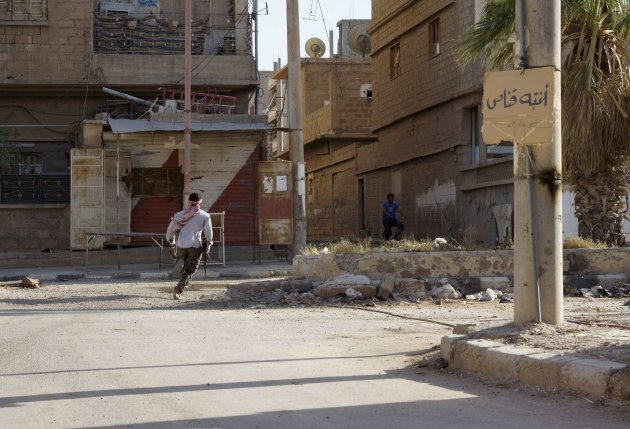
The White House announcement that President Barack Obama has decided to provide direct military aid to Syria?s rebels didn?t include the word ?arms.? And the word ?weapons? only appears as part of ?chemical weapons,? as in ?our intelligence community assesses that the Assad regime has used chemical weapons.?
In fact, Deputy National Security Advisor Ben Rhodes, who detailed the decision on a conference call with reporters late Thursday, repeatedly declined their invitation to detail what, exactly, Washington is sending to try to tip the balance in the opposition?s favor.
?This is more a situation where we're just not going to be able to lay out an inventory of what exactly falls under the scope of that assistance other than to communicate that we have made that decision,? Rhodes said. (He used variations on the ?inventory? line at least four times during the call).
That?s a little odd. Here?s how National Security Council spokeswoman Caitlin Hayden described a decision to escalate aid to the rebels on April 30, 2013: ?Additional communications equipment, armor, night vision goggles, and vehicles are among the items that are being discussed.? That?s?.inventor-ish.
What if the White House's new strategic vagueness aims to hide the fact that Obama is looking at sending more Americans to Syria?
"More," because it's an open secret that the CIA and US special forces have people on the ground in Syria to help train the rebels and to make sure the weapons flowing into the country reach moderate elements of the opposition, not the al-Qaida-affiliated fighters. The U.S. took a similar approach during the conflict in Libya, known as "wingtips on the ground" -- as opposed to "boots on the ground," which might both require greater Congressional input and raise the hackles of the war-weary U.S. public.
Sending more Americans might make strategic sense: The fractious opposition in Syria has struggled with command-and-control, and sending advanced communications equipment won't solve that. If Washington is sending advanced weapons, someone will need to show the rebels how to use them. And U.S. officials have long worried about fitful cooperation between rebel fighters and the political wing of the opposition.
The Americans wouldn't have to be based in Syria -- they could go to neighboring Turkey or Jordan, both of which have taken in hundreds of thousands of refugees.
This approach would also fit Rhodes's description of what Obama has decided to do in Syria. Again, from the Thursday conference call:
"It will cover a range of different purposes, and it?s aimed at strengthening both the cohesion of the opposition, but also the effectiveness of the SMC [the rebels' Supreme Military Council] on the ground."
"The president has taken the decision to provide that type of direct support to the SMC that has military purposes. And we're looking at a wide range of types of support we can provide both to the political opposition and to the SMC on the ground."
"The President has made a decision about providing more support to the opposition. That will involve providing direct support to the SMC. That includes military support. I cannot detail for you all of the types of that support for a variety of reasons, but suffice it to say this is going to be different in both scope and scale in terms of what we are providing to the SMC than what we have provided before."
You get the picture.
What about a no-fly zone? Reuters reported Friday that the Obama administration was considering it. The Wall Street Journal laid out how it might unfold in a report on Thursday.
That would certainly cheer Congressional hawks.
"Providing arms alone is not sufficient. That alone is not enough to change the military balance of power on the ground against Assad," Republican Senators John McCain and Lindsey Graham said in a joint statement on Thursday. "The president must rally an international coalition to take military actions to degrade Assad?s ability to use airpower and ballistic missiles and to move and resupply his forces around the battlefield by air. This can be done, as we have said many times, using stand-off weapons such as cruise missiles."
But it doesn't seem to be in the cards at this point, at least to hear Rhodes tell it.
"We have not made any decision to pursue a military operation such as a no-fly zone," Rhodes said.
"A no-fly zone, while there is a contingency plan for many different things, would carry with it great and open-ended costs for the United States and the international community," he continued. "It?s far more complex to undertake the type of effort, for instance, in Syria than it was in Libya," Rhodes said.
Unlike Libya, Syria has advanced anti-aircraft defenses that would make enforcing a no-fly zone far more dangerous for American or allied warplanes.
Rhodes also said there was no guarantee a no-fly zone would improve matters on the ground.
"You have regime forces and irregular regime-associated forces essentially commingled with opposition forces in a civilian population. That is a very hard challenge to get at from the air," he argued.?" That doesn?t mean that we?ve ruled anything out other than the provision of U.S. boots on the ground -- which nobody has suggested," he said.
Source: http://news.yahoo.com/blogs/ticket/obama-send-more-americans-syria-150835028.html
ash wednesday kate middleton marco rubio marco rubio Zero Hour Funny Valentines Chris Kyle
No comments:
Post a Comment
Note: Only a member of this blog may post a comment.